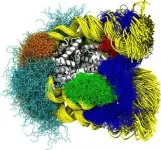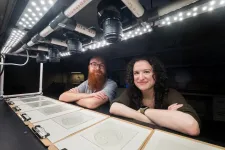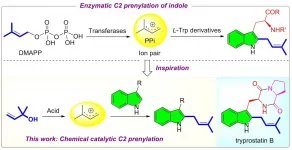(Press-News.org) Researchers from the Hubrecht Institute in Utrecht (The Netherlands) and the Max Planck Institute for Molecular Biomedicine in Münster (Germany) used computer simulations to reveal in atomic detail how a short piece of DNA opens while it is tightly wrapped around the proteins that package our genome. These simulations provide unprecedented insights into the mechanisms that regulate gene expression. The results were published in PLOS Computational Biology on the 3rd of June, 2021.
Every cell in the body contains two meters of DNA. In order to fit all the DNA in the cell's small nucleus, the DNA is tightly packed in a structure known as chromatin. Chromatin is an array of identical smaller structures named nucleosomes. In a single nucleosome, DNA is wrapped around 8 proteins called histones. Chromatin is not uniformly compact across the genome. The tightness of the packaging is important in regulating which genes are expressed and therefore which proteins are produced by a cell.
Transitions from tightly to loosely packed DNA - from closed to open chromatin - are essential for cells to convert to another cell type. These cell conversions are hallmarks of development and disease, but are also often used in regenerative therapies. Understanding how such transitions occur may contribute to understanding diseases and optimizing therapeutical cell type conversions.
Computational nanoscope
One step in the opening of chromatin is the motion of DNA while wrapped in nucleosomes. Like all molecular structures in our cells, nucleosomes are dynamic. They move, twist, breathe, unwrap and wrap again. Visualizing these motions using experimental methods is often very challenging. One alternative is to use the so-called "computational nanoscope".
Researchers use the term computational nanoscope to refer to a set of computer simulation methods. These methods enable them to visualize the movements of molecules over time. Over the past years, the methods have become so accurate that researchers started referring to them as a computational nanoscope; observing the molecules moving on the computer is similar to observing them under a very high resolution nanoscope.
Nucleosomes breathing
Jan Huertas and Vlad Cojocaru, supported by Hans Schöler from the Max Planck Institute for Molecular Biomedicine (Münster, Germany), generated multiple real-time movies of the movements of nucleosomes, each covering one microsecond from the nucleosome lifetime. Using these movies, they monitored how the nucleosomes open and close in a motion known as nucleosome breathing.
In their new paper, published in PLOS Computational Biology, Huertas and Cojocaru describe what causes nucleosome breathing. First, they found that the order in which the building blocks of DNA are arranged - the DNA sequence - is important for nucleosome breathing. Second, the dynamics of histone tails are essential for this process. These histone tails are flexible regions in the histones that play a role in the regulation of gene expression. While the role of histone tails has been studied intensively, little is known about how they influence the motions of single nucleosomes. With their simulations, Huertas and Cojocaru described the relationship between histone tails and nucleosome breathing in atomic detail.
Histone modifications
"Being able to observe the breathing of nucleosomes in computer simulations is very challenging. The fact that we have now been able to visualize this represents a major step towards simulating the complete spectrum of nucleosome dynamics, from breathing to unwrapping. It also allows us to study how these motions are affected by modifications of the histones, which occur in different cells and regions of our DNA. Our simulations revealed that two histone tails are responsible for keeping the nucleosome closed. Only when these flexible tails moved away from particular regions of DNA, the nucleosome was able to open," says the research leader, Vlad Cojocaru.
Jan Huertas, first author in the publication and recent PhD-graduate, adds: "Active (open) and inactive (closed) chromatin contain different modifications of histone tails. The next step is to perform simulations with such modifications. The atomic resolution of the simulations would allow us to pinpoint how each modification affects nucleosomes and chromatin dynamics."
Towards understanding epigenetics
All three researchers are excited about the future of the use of atomistic computer simulations in understanding gene expression mechanisms in development and disease. "With the further increase of computational power available in the world, we will soon be able to simulate milliseconds of a nucleosome lifetime with all its atoms included. Furthermore, we will be able to routinely simulate multiple nucleosomes to study the effect of different modifications of histones on gene expression. This will give unprecedented insights into the mechanisms that regulate gene expression," Cojocaru concludes.
INFORMATION:
Jan Huertas, Hans Robert Schöler, Vlad Cojocaru
Histone tails cooperate to control the breathing of genomic nucleosomes
PLOS Computational Biology, June 03, 2021
Health has always been affected by climate and weather, but is increasingly clear that the change in climate is a significant threat to human health. The World Health Organization (WHO) estimates that 24% of global deaths are linked to environmental factors [1]. Climate change and pollution can lead to undernutrition, mental disorders, and noncommunicable diseases including chronic kidney disease and acute kidney injury [2].
The burden of addressing the death and disability associated with climate change falls to nephrologists and other healthcare professionals. At the same time, the healthcare sector makes a major ...
SGLT2 inhibitors (gliflozins) were developed as oral antidiabetics. They enhance urinary glucose excretion by inhibiting SGLT-2 (sodium-dependent glucose co-transporter-2) in the renal tubuli. The discovery of kidney benefits beyond the lowering of blood sugar has been made by Professor Christoph Wanner from Germany: The EMPA-REG OUTCOME study [2] initially showed that the rate of cardiovascular events in type 2 diabetic pa-tients is significantly reduced if the SGLT2 inhibitor empagliflozin is administered. Kidney function in diabetics who already had diabetic nephropathy was also found to benefit sig-nificantly from the treatment ...
HOUSTON - (June 7, 2021) - If identical versions of 20 people lived out their lives in dozens of different worlds, would the same people be popular in each world?
If you substitute "fruit flies" for "people" in that question, you have a fair description of a Rice University study showing that the evolution of social structures and the positions of individuals within those structures are based partly on genetics.
Cloned fruit flies played a starring role in the study that researchers jokingly likened to "The Truman Show," with video cameras observing how the flies behaved in a controlled environment.
In the study published online this week in Nature Communications, Rice bioscientists Eric Wice and Julia Saltz ...
The kidneys are a target organ of COVID-19 and are affected very early in the course. However, this is precisely where there is strong prognostic potential: As early as last spring, COVID-19-associated nephritis was identified as an early warning signal for severe courses of the infectious disease and studies to that effect were published [1]. In that regard, the research group led by Professor Oliver Gross, Department of Nephrology and Rheumatology at Göttingen University Medical Center (UMG), screened 223 patients in a study and included 145 of them as a predictive cohort. Study endpoints were ICU admission or mortality. As a result, early urinary changes ...
It was clear at a relatively early stage of the pandemic that SARS-CoV-2 causes a wide range of symptoms; in addition to typical respiratory symptoms, patients also had neurological symptoms (starting with anosmia), gastrointestinal symptoms, elevated liver values, and renal, urinary or hematological changes, for example. The fact that such findings occurred not only in severely ill patients with general organ dysfunction suggested that the virus may potentially cause disorders in various organs directly, i.e. that it causes a multi-system disease.
In spring 2020, at the very beginning of the pandemic, the authorities in Hamburg ordered autopsies be performed on all patients who had died with COVID-19. This resulted in one of the ...
Various viruses and bacteria have long been known to cause autoimmune diseases where there is such a predisposition. This phenomenon also seems to play a major role in SARS-CoV-2, especially in severe courses. The body's own immune cells are activated, with the formation of autoantibodies that attack the body's own healthy cell structures (proteins, autoantigens); deposits of immune complexes can then trigger severe inflammatory processes and cell destruction in the body.
Some nephrological diseases are likewise of autoimmunological etiology, one example being systemic lupus erythematosus (SLE), a chronic, mostly relapsing-remitting inflammatory disease with life-threatening ...
Terpenoids are omnipresent in almost all living organisms. Prenylated indoles are prominent representatives that usually display potent medicinal properties (e.g. tryprostatin B). Therefore, significant efforts have been devoted to indole prenylation over the past decades. The known protocols often require a multi-step procedure and rely on the use of stoichiometric promoters. From the viewpoint of step- and atom-economy, developing a direct catalytic C2 prenylation of indoles is highly desirable yet challenging, because the nucleophilicity of C2 site is weaker than that of other two positions ...
Consuming large amounts of daily caffeine may increase the risk of glaucoma more than three-fold for those with a genetic predisposition to higher eye pressure according to an international, multi-center study. The research led by the Icahn School of Medicine at Mount Sinai is the first to demonstrate a dietary - genetic interaction in glaucoma. The study results published in the June print issue of Ophthalmology may suggest patients with a strong family history of glaucoma should cut down on caffeine intake.
The study is important because glaucoma is the leading cause of blindness in the United States. It looks at the impact of caffeine intake on glaucoma, ...
Research Highlights:
Rates of Kawasaki disease - a condition that creates inflammation in blood vessels in the heart and is more common in children of Asian/Pacific Island descent - have substantially decreased in South Korea during the COVID-19 pandemic.
The decrease could be due to mask-wearing, hand-washing, school closures and physical distancing, suggesting Kawasaki disease may be prompted by infectious agents.
The cause of Kawasaki disease is unknown, though it may be an immune response to acute infectious illness.
DALLAS, June 7, 2021 -- The rate of Kawasaki disease in South Korea has substantially decreased during the COVID-19 pandemic, possibly due to pandemic prevention efforts, such as mask-wearing, ...
CAMBRIDGE, MA -- MIT engineers have discovered a new way of generating electricity using tiny carbon particles that can create a current simply by interacting with liquid surrounding them.
The liquid, an organic solvent, draws electrons out of the particles, generating a current that could be used to drive chemical reactions or to power micro- or nanoscale robots, the researchers say.
"This mechanism is new, and this way of generating energy is completely new," says Michael Strano, the Carbon P. Dubbs Professor of Chemical Engineering at MIT. "This technology is intriguing because all you have to do is flow a solvent through a bed of these particles. ...


